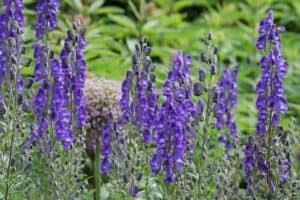What Exactly Is Wolfsbane?
In the mountainous regions of Europe, Asia, and North America, wolfsbane, also known as aconitum, is a perennial plant. Due to their toxic nature, these invasive plants have been labelled as nuisance weeds among garden plants even though they have stunning purple bell-shaped flowers that make them stand out.
Learn everything there is to know about wolfsbane, which grows in gardens, along roadsides, and in natural areas all over the UK.
What distinguishes it from other plants?
The buttercup family includes the perennial herb wolfsbane. These flowering plants have a distinctive appearance, a thick, hairy stem, and large, lobed or divided basal leaves. They typically reach heights of 2 to 4 feet. Usually, the lower surface of the leaves is paler and fuzzy and the upper surface is dark green and glossy.
The pink flowers of wolfsbane, which are usually blue or purple and are arranged in a large, helmet-like structure known as an inflorescence, are the plant’s most striking feature. The five-petal flowers are typically spiralled along the stem. The plant’s reproductive organs are encased in a sizable, hood-like structure called the upper sepal, which is present in every flower.
Late summer or the beginning of fall is when these shrub-like weed plants bloom, and the flowers may last for several weeks. The plant produces achenes, which are tiny, dry fruits that resemble seeds and are dispersed by the wind after it blooms.
How dangerous is Wolfsbane?
Wolfsbane is one of the most unwelcome plants, despite its attractive appearance, and is highly toxic, according to the Wildlife and Countryside Act. The poisonous alkaloid aconitine, which is present in all parts of the invasive climbing weed plant, can result in serious symptoms if consumed. Numbness, tingling, and a burning sensation in the mouth and throat are possible side effects of aconitine. Additionally, it may result in nausea, vomiting, and diarrhoea. It has occasionally been reported to result in heart palpitations, seizures, and even disease.
It has been reported that many livestock has passed after ingesting the poisonous weed wolfsbane, which is also toxic to grazing farm animals. The toxic alkaloids in the plant can also be absorbed through the skin, making it dangerous to handle.
What are the uses for it?
These indigenous plants are poisonous, but some cultures worldwide still use them in traditional medicine. It has been used for centuries for a variety of things, including lowering pain and fever, but if consumed in large amounts, it can also be fatal. It was also used to make poisons for use in hunting and combat, as well as to poison arrows.
It is frequently connected to werewolf legends in folklore and popular culture, and if consumed or used as a weapon, it is said to fend off or kill werewolves. Wolfsbane can be used as medicine, but it must always be done so under the supervision of a trained medical professional.
How can you manage Wolfsbane?
Once it has spread throughout a region, the weed wolfsbane can be difficult to eradicate. Because it can grow in different types of soil and has a deep taproot, the plant is challenging to get rid of. Preventing wolfsbane from spreading in the first place is the best way to manage it. To accomplish this, clear the area of any plants and keep an eye out for any new growth.
Once the wolfsbane weed is established, there are a number of approaches you can take to control it, each with pros and cons of their own.
Pulling out by hand
Using this technique, the plant and its roots must be physically pulled out of the ground. It works well with other control strategies and is most effective for early and small plant populations. It can be labour-intensive, though, and is impractical for large areas.
The plant is poisonous, and all parts—including the roots, leaves, stem, and flowers—contain poisonous alkaloids that can cause serious symptoms if consumed or touched. Therefore, if you’re hand-pulling, make sure you have enough safety gear including gloves, full-length clothing and goggles.
Use of chemicals
Herbicides can be a useful tool for managing wolfsbane. But it’s important to pick the right herbicide and carefully follow the directions because some herbicides might not work against the plant or might be harmful to other plants and animals. Be extremely cautious and only ever use herbicides that are permitted by UK law.
Natural prevention
In order to control the population of the plant, this technique makes use of different living things like insects or diseases. Although it may take some time to set up and maintain, this can be a long-term, viable solution.
Cultural management
Using this technique, the plant’s ability to thrive is made more challenging by changing the growing environment. For instance, putting taller plants around the plant to block out sunlight, or altering the soil to make it less conducive to the plant’s growth. This method is tricky, and you need to have a good understanding of plants and their growth to achieve the depletion of wolfsbane using this method.
Combination of methods
One technique alone may not be as effective as several. For instance, using herbicides for larger areas, hand-pulling small plant populations, and cultural control techniques to stop new growth.
It is significant to remember that timing is essential for controlling wolfsbane, as it is with all weed control techniques. The best time to deal with it is when it is in the flowering stage, when the plant concentrates the majority of its energy on reproduction and is therefore more susceptible to control measures.
To control wolfsbane, you can also use chemical herbicides, but you should be careful not to harm nearby animals and plants and have a good understanding of which herbicides to use, how to use them, and only if they are permitted for use in an area under UK law. Research is being done on potential biological control strategies for this weed, including the use of insects and pathogens.

In Conclusion
Despite having an exotic and lovely appearance, wolfsbane is a toxic weed that is dangerous to both people and animals. It is crucial to act quickly to control any wolfsbane that may be growing on your property, but you must also keep yourself and others away from the plant. It is always best to seek professional advice if you have any questions about wolfsbane, such as from a botanist or a weed removal specialist like Green Leaf Remediation.
We have many years of experience in the invasive weed industry and have experts who understand and have the experience to manage and eradicate invasive weeds found in the UK.
You can find us here on the Property Care Association website.
Contact us today at 07531 142316 and one of our experts will be able to advise you. We are a local, family-owned business that provides dependable, honest services.

Martyn works for Green Leaf Remediation as a marketing specialist. He takes great pride in creating quality content regarding Japanese knotweed.
